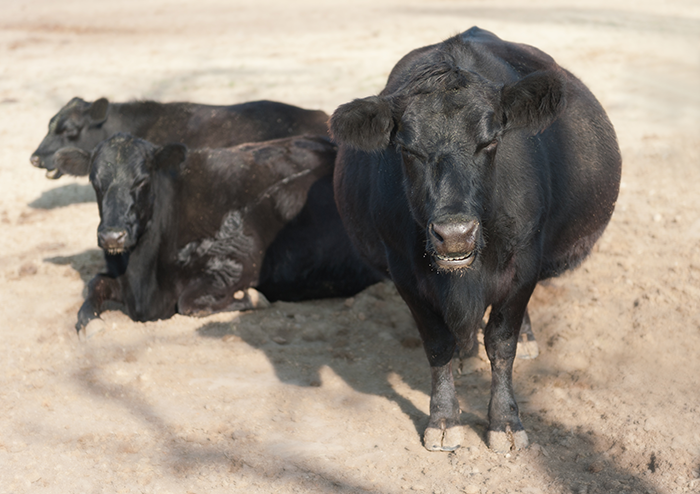
As the end of the growing season is on the horizon and there is less forage regrowth, grazing hayfields, rather than harvesting a final cutting, is a cost-effective strategy where feasible. While producers all over the U.S. regularly graze alfalfa and other legumes, precautions to prevent bloat are necessary.
Bloat is commonly understood by producers as gas buildup in the rumen, but a better understanding of bloat type, cause, and effective mitigation are also important considerations before grazing alfalfa.
Simply put, bloat occurs when gas is produced in the rumen as a by-product of digestion and exceeds gas expulsion, primarily through cow belches while ruminating. In most cases of digestive bloat — and nearly all cases of bloat from forage diets — the gas produced is trapped in a stable foam, creating “frothy” bloat.
The main dietary components believed to attribute to foam formation include soluble leaf proteins, saponins, and hemicelluloses. All three of these compounds are found in elevated levels in alfalfa compared to most perennial grasses. Bloat risk is elevated in vegetative alfalfa because its highly digestible components allow plant cells to be broken down faster, making those compounds available at a more rapid rate, exacerbating foam production and gas entrapment. In more fibrous or higher lignin forages, digestion occurs slower. Plus, cattle ruminate more, aiding in saliva production, which has anti-foaming properties.
Bloat can and often does occur to a lesser degree in which no intervention is needed. However, when acute cases of bloat arise, rumen distention causes issues with respiration, and the ultimate cause of death is typically suffocation. In herds experiencing bloat, one can typically find a range of severity among animals.
To combat cases of frothy bloat, strategies to relieve the gas buildup, like inserting a tube down the esophagus, are not very effective. Rather, using something to break down bubbles is necessary. Antifoaming agents that have been shown to be effective treatments in emergency situations include vegetable or mineral oils, poloxalene, and other surfactants. In mild cases, encouraging animals to walk or consume fibrous feed can help relieve symptoms.
Take these precautions
Like most health challenges, prevention is the most effective solution for bloat. If grazing alfalfa this fall is an option for you, take a multifaceted approach and consider these recommendations to reduce the risk of bloat.
Diet adaptation. Like all dietary changes, a gradual acclimation period is warranted. For grazing alfalfa, this may look like limiting access to an alfalfa stand for a couple hours a day and elongating the time on the stand over a week or so. Another approach might be to strategically graze pastures with a rigorous stand of legumes leading up to alfalfa turnout.
Supplement with bloat-reducing compounds. Poloxalene is an effective anti-foaming compound that can be supplemented to cattle to prevent bloat. This product is often fed through molasses bloat blocks but can also be fed as a topdressing or mixed in a grain supplement. Be sure to follow label directions on the feeding duration before turnout and the amount that needs to be consumed for effectiveness. Supplementation needs to continue after turnout and until the bloat risk is gone.
Another supplement option to reduce bloat risk is an ionophore. Because of the influence an ionophore has in shifting the microbe population, gas production can be somewhat reduced.
Graze stands with adequate grass and alfalfa maturity. For reduced risk, ensure the stand contains a minimum of 50% grass, especially a hayfield that is still growing. The grass will provide much needed effective fiber to create the scratch factor that contributes to saliva production and slows forage digestibility.
For both the grass and alfalfa, maturity matters for fiber content. As alfalfa matures, lignin content rises due to secondary cell wall thickening, which slows digestion. A similar bump in effective fiber occurs as grass matures. Ensure alfalfa is blooming before turnout to reduce risk. The more mature, the lower the bloat risk will be.
After a frost, wait before grazing. After a frost, plant cells rupture, leading to soluble proteins and carbohydrates being more readily available to rumen microbes, which drastically intensifies bloat risk. Even a light frost can heighten the risk. However, after alfalfa completely stops growing and goes dormant after a killing frost, any future frosts will not enhance bloat risk.
If alfalfa shows signs of regrowth, wait a couple days after each frost event before grazing. This may require removal of animals ahead of a frost. In terms of weather events, also be cautious not to graze after a drought-relieving rain, as rapidly growing forage also poses significant bloat risk.
Turn out later in the day. In general, grazing cattle consume the largest meal of the day in the early morning hours. If given access to a fresh paddock first thing in the morning, hungry cattle will eat fast and gorge themselves on the palatable, readily available alfalfa. By shifting to an afternoon turnout, cattle have the opportunity to fill up before grazing alfalfa, and slower consumption will help the rumen adjust to the new feed source. Additionally, dew on alfalfa in the morning can amplify bloat risk.
It is impossible to graze alfalfa without taking on some risk of bloat. However, there can be big performance and cost-saving rewards of doing so. Preparing cattle beforehand and observing them after turnout are essential elements to success. With that said, reach out to your extension specialist or nutritionist if you are on the fence about grazing alfalfa.
This article appeared in the August/September 2025 issue of Hay & Forage Grower on page 28.
Not a subscriber? Click to get the print magazine

